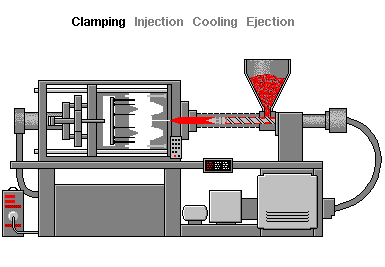Mon - Fri: 8:30 - 17:00
+64 9 820 1520Call us Today
enquiries@tcinz.co.nzEmail us
The following AVI illustrates the fundamentals of Injection Moulding. The video clearly shows the four main functions of an injection moulding machine: clamping, injection, cooling and finally ejection - of course there are several vital functions happening during these main functions so much so that all modern machines have an on-board computer.
A mould is bolted into the CLAMPING section of the machine. The machine closes the mould, then applies a large force to “Lock” the mould closed. Inside the closed mould is a cavity that is the exact shape of the plastic part.
The INJECTION section of the machine has a hopper to hold plastic pellets; a barrel with heater bands to liquefy the plastic pellets; a feed screw to move the pellets forward in the barrel; a check valve to force the liquid plastic into the mould and a nozzle to seal the injection section to the mould. The liquefied plastic is forced into the cavity of the mould with high pressure.
Once the liquid plastic has been injected into the mould the machine goes into the COOLING phase. The liquid plastic must cool enough to turn solid so it takes on the shape of the cavity and stays that way. While the cooling takes place, the screw will rotate, bringing in more pellets for the next part.
When the part is ready to be removed from the mould, the clamp will open and the part will be removed from one half of the mould. Then the part will be EJECTED from the other half of the mould and a new cycle will start.

Gas-assisted injection moulding is a significant manufacturing advancement, it is a low-pressure process utilising nitrogen gas to apply uniform pressure throughout the moulded plastic part. By displacing molten plastic from thicker sections of the part toward areas in the cavity that are last to fill, nitrogen gas pressure creates channels within the part. Through the gas channels, pressure is transmitted evenly across the part; eliminating warpage, sink marks and internal stress. As a result, clamp tonnage, cycle time and part weight is significantly reduced, while increasing the strength and rigidity of the part.
Gas Assist Injection Moulding allows the freedom to design plastic parts without the restrictions limitations inherent to conventional moulding.
Thin wall parts with heavy ribs, bosses and gussets are formed to high standards of flatness without sink marks or long cycle times. Long shapes are produced without multiple drops or hot runner systems, eliminating weld lines and notably lowering tooling costs. Multiple parts with complex design and differing wall thickness are moulded as a single part without defect. Clamp tonnage requirements are dramatically reduced in most gas assist applications. There are essentially two methods: